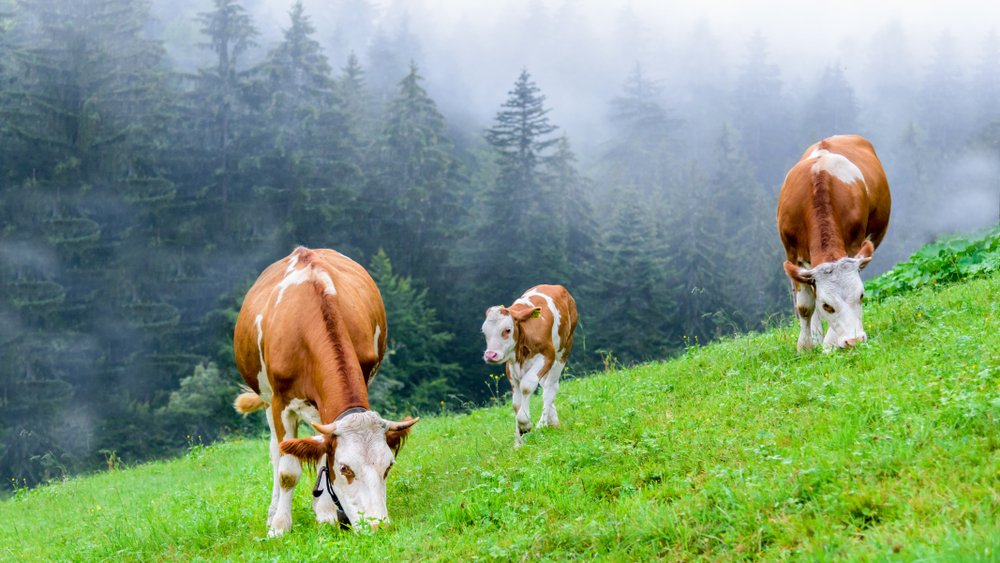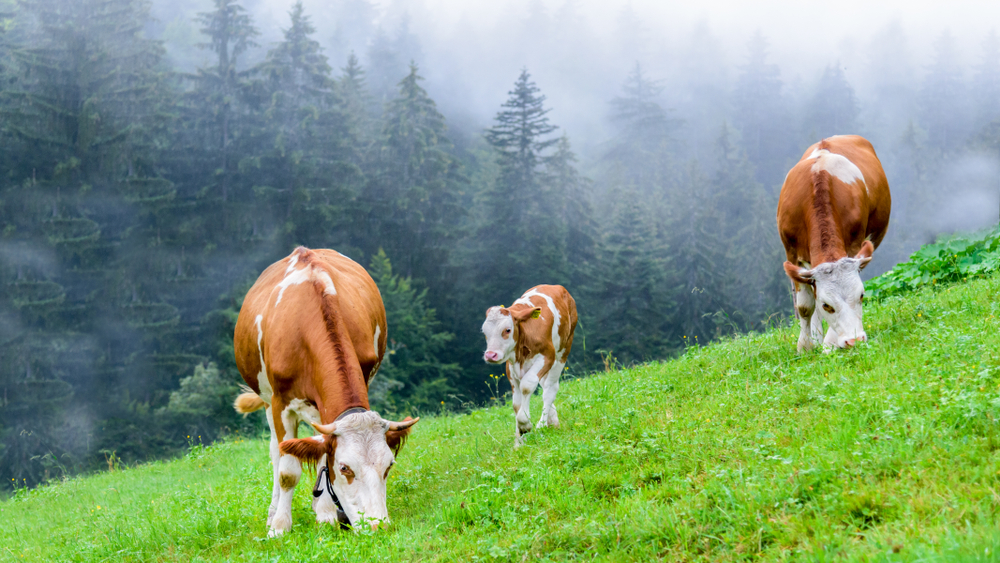
This article was originally published on Nexus Media.
On a clear April morning, after milking his seven cows, Tim Souder surveyed the pasture where he had just turned the animals out to graze. Like many dairy farms, Sauder’s fields swayed in a variety of greens: chicory, alfalfa and clover. But they were also full of something that is usually missing from the agricultural landscape – trees. Thousands of them.
Between 2019 and 2021, Sauder planted 3,500 trees at Fiddle Creek Dairy, a 55-acre family farm in Lancaster County, Pennsylvania, where he and his wife raise cows for yogurt, cheese and beef production. Today, young trees of willow, hickory, poplar, pecan and persimmon inhabit the pastures, and on the crisp spring morning rows of honey and locust, bur and cow oaks were beginning to leaf out, casting shadows on the long grass below.
Sauder said planting trees has always been a priority; before he filled his pastures with them, the farm was home to a small orchard as well as riparian buffers—trees planted along the creek to prevent erosion and preserve water quality. But the trees under which his cattle now graze represent a fundamental change in his work.
The Sauders stake the farm, so to speak, on silvopasture, the ancient practice of raising animals and trees and pasture on the same piece of land (Silva is forest in Latin). In a forest-pasture setting, farmers carefully manage each element to benefit the other—relying on manure to fertilize trees, for example, or fallen fruit to feed livestock—resulting in a system that is greater than the sum of its parts. parts.
It’s an old idea that’s gaining modern popularity. Last year, the USDA awarded the Nature Conservancy and numerous partner organizations $64 million grant to advance agroforestry — the general term for agricultural practices that involve trees — by providing technical and financial assistance to farmers who want to make a difference. This year’s farm bill could mean a new infusion of funding, as well as an expansion of existing agroforestry programs to more clearly include rangelands.
“The USDA is doing a lot, but a lot more can be done,” said Jabob Grace, communications project manager at the Savanna Institute, a nonprofit that promotes agroforestry practices. His organization is pushing for the 2023 farm bill to increase appropriations for the National Agroforestry Center, the only state agency dedicated to the practice, from $5 million to $25 million (Grace said the Center is chronically underfunded, having never did not receive more than 2 million dollars per year) . They are also pushing for the creation of regional agroforestry centers, the development of a USDA agroforestry technical assistance program, and more grants designed to help farmers like Sauder establish an easy pasture system.
In Sauder’s pastures, “every tree has multiple benefits,” he explained. Mulberry leaves contain more protein than alfalfa, and the seed pods dropped by the honey locust each fall are full of sugar; these trees were selected to supplement the animals’ diet. Sauder chose other tree species with leafy crowns to protect the health of his herd. “Come August, there’ll be shade here when the cows need it.”
Providing shade may seem like a matter of comfort, but it can actually be a matter of life and death. Last summer, thousands of cattle died in Kansas after the region was rocked by historic heat and humidity. As the climate warms, researchers believe deaths like the one in Kansas will become more common. But even when cattle survive a brutally hot summer, the effects of heat stress can wreak havoc on a farm’s bottom line.
Grace said the farmers she works with are worried about what warmer temperatures mean for their livelihoods.
“When we talk to our growers about pastures, the first thing they’re interested in is shade,” Grace said. “They notice the higher temperatures. Their cattle are inconvenient, they do not bid. The money is almost directly out of that farmer’s pocket when they overheat the cattle.”
A lot of money, actually. A 2022 survey of Cornell University predicts that cattle herd losses due to heat stress will total $15 billion to $40 billion annually by the end of the century. To avoid these losses, the authors note, “tree-livestock systems can be very effective in reducing heat stress.” And Farm Bill funding could help more farmers get started.
Shade is one way silvopasture keeps costs down, but there are others. Some poultry farmers use the method for guard their flocks from birds of prey. Vineyards and Christmas tree farms are increasingly turning around of grazing animals for mowing and weed control.
But the rangeland system can do more than just save farmers money; it can help them diversify what they grow. Perhaps one of the oldest—and most profitable—examples of forest pasture is dehesa system in southern Spain, where Iberico pigs roam towering oak trees, feasting on acorns and fertilizing the soil, resulting in some of the world’s most expensive hams and a cash crop of cork. While livestock health and income are compelling reasons for farmers to practice grazing, perhaps the most compelling benefit of the method is its potential as a climate solution.
Project Drawdown, a nonprofit that analyzes climate solutions, ranks silvopasture as the 11th the most effective strategy to combat climate change—well ahead of solar panels, recycling and electric cars—finding that grasslands with trees isolate five to 10 times as much carbon as grasslands of a similar size but without trees.
The perennial roots of the pasture system can also help stabilize the soil, preventing erosion as well as flooding, which become more frequent with heavier rains. Additionally, a well-managed grazing operation can reducing forest fire load — thanks to carefully spaced and pruned trees, as well as grazing animals that control the understory — and an increase in biodiversity.
What’s more, when livestock can eat the feed that’s right in front of them, the gas-guzzling farm equipment and trucks normally used to deliver feed to feedlots can stay in the park. “Reducing harvesting and shipping means a significant reduction in greenhouse gases,” Grace explained.
According to Grace, large parts of the American Midwest were covered by a kind of natural grassland, an oak savanna ecosystem where grazing animals such as bison grazed on the prairie under fruit and nut trees. Many indigenous cultures adopted and benefited from this form of land management until European settlers began to deforest the region, eventually building farms that operated more like factories.
This emphasis on efficiency has led to widespread monocultures and annual cropping systems where, Grace said, “for a good part of the year, not much happens.”
Today, only about 1.5% of U.S. farmers (approximately 31,000) practice some form of agroforestry, including silviculture, 2017 USDA study revealed. But as summers get hotter and climate forecasts more dire, interest in the practice is booming. Matthew Smith, a research program manager at the USDA’s National Agroforestry Center, said “the demand for knowledge and information about forest rangelands is higher than anyone can provide.”
This is because grazing is more complex than letting livestock run free in the forest; this requires choosing the right trees and forage for the local climate and constantly moving livestock from one place to another.
“If people are interested in forest pasture, they really need to have experience in rotational grazing beforehand … which is hard to learn,” Smith said. “Things can quickly go wrong when all your crops are in the same place.” Livestock left in one place for too long can damage trees, for example, and plants grown too close together can compete with each other for light and nutrients.
There are other challenges. On the one hand, easy pasture systems require a large area of land and more hours of labor – at least initially – to maintain. Also, it takes many years for trees to grow and begin to provide significant benefits. But the biggest obstacle for most farmers who want to practice grazing is the high cost of buying, planting and maintaining trees.
Most rangeland operations rely on grants and cost-sharing programs from organizations like the Natural Resources Conservation Service and the USDA, programs that advocates like Grace say are in dire need of the increased funding and staffing that this year’s farm bill could provide. Grace said the handful of existing agroforestry programs, such as the Conservation Reserve Program and the Environmental Quality Incentive Program, are vague in their wording and should be changed to more clearly fund rangeland projects and provide additional opportunities to share the costs of farmers.
Savanna Institute ally and climate NGO Carbon 180 recommends that the 2023 farm bill increase the share of federal spending to 75% for agroforestry practices to help cover upfront costs and ensure farmers have access to high-quality, regionally appropriate trees and shrubs.
Meanwhile, funding remains “a major barrier to farmers hoping to pursue forest pasture,” said Austin Unruh, owner of Trees for Graziers, who helped Tim Soder secure money from the NRCS office in Pennsylvania. Unruh, whose business has helped about 25 farms introduce grazing over the past three years, said helping farmers pay for it “has been frustrating. Each time it’s a different source of funding, different hoops to jump through.”
For Sauder, financial assistance from the state was paramount. He said without it, the trees in his pasture simply wouldn’t be there, “at least not for the next 20 years.”
He admits the new system took a lot of work in the beginning, but he expects to pay off in the form of healthier pastures, soil and cows — and hopefully the ability of his land to support more of them.
Still, working in tandem with nature inspires Sauder the most. Running his farm with an overriding concern for the health of the ecosystem, he said, is like making up for the mistakes of his Mennonite immigrant ancestors who displaced the native population and bent the land to their will.
“I’m rethinking what would have happened if they had arrived here and instead said, ‘What’s the best way to live in this place?'”

